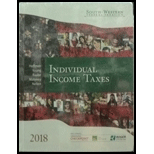
South-western Federal Taxation 2018: Individual Income Taxes
41st Edition
ISBN: 9781337385886
Author: William H. Hoffman, James C. Young, William A. Raabe, David M. Maloney, Annette Nellen
Publisher: Cengage Learning
expand_more
expand_more
format_list_bulleted
Textbook Question
Chapter 20, Problem 42P
LO.3, 8 Robin had the following capital transactions in 2018:

Robin also had a net long-term capital loss in 2017 of $2,000, which it could not use, and ordinary income of $13,000. What are the tax consequences in 2018 if:
- a. Robin is an individual.
- b. Robin is a C corporation.
- c. Robin is an S corporation.
Expert Solution & Answer
Want to see the full answer?
Check out a sample textbook solution
Students have asked these similar questions
Suppose Chrysler Motors has 720 million shares outstanding with a share price of $68.25, and $30 billion in debt. If in three years, Chrysler has 750 million shares outstanding trading for $76 per share, how much debt will Chrysler have if it maintains a constant debt-equity ratio? Accounting Answer
Give me Answer
Compute the company's plantwide predetermined overhead rate for the year
Chapter 20 Solutions
South-western Federal Taxation 2018: Individual Income Taxes
Ch. 20 - Prob. 1DQCh. 20 - LO.1 Sylvia and Trang want to enter into business...Ch. 20 - Prob. 3DQCh. 20 - Prob. 4DQCh. 20 - Prob. 5DQCh. 20 - Prob. 6DQCh. 20 - LO.3, 4, 5 Contrast the income taxation of...Ch. 20 - LO.3, 8, 9 The taxpayer has generated excess...Ch. 20 - Prob. 9DQCh. 20 - Prob. 10DQ
Ch. 20 - Prob. 11DQCh. 20 - Prob. 12DQCh. 20 - Prob. 13DQCh. 20 - Prob. 14DQCh. 20 - Prob. 15DQCh. 20 - Prob. 16DQCh. 20 - Prob. 17DQCh. 20 - Prob. 18DQCh. 20 - Prob. 19DQCh. 20 - Prob. 20DQCh. 20 - Prob. 21DQCh. 20 - Prob. 22DQCh. 20 - Prob. 23DQCh. 20 - Blaine, Cassie, and Kirstin are equal partners in...Ch. 20 - Prob. 25DQCh. 20 - LO.3 Green Corporation, a calendar year taxpayer,...Ch. 20 - Prob. 27CECh. 20 - Banana Corporation is a May 31 fiscal year...Ch. 20 - LO.4 Gold and Silver are two unrelated calendar...Ch. 20 - Maroon Corporation is a calendar year taxpayer....Ch. 20 - Prob. 32CECh. 20 - Prob. 33CECh. 20 - Prob. 34CECh. 20 - Drab Corporation, a calendar year S corporation,...Ch. 20 - Kim is a 40% shareholder in Taupe Corporation, a...Ch. 20 - Prob. 37CECh. 20 - LO.3, 4, 5 Using the legend provided below,...Ch. 20 - LO.3 Garnet has the following capital asset...Ch. 20 - LO.3, 8 Citron, a calendar year taxpayer, began...Ch. 20 - LO.3 Taupe, a calendar year taxpayer, has a...Ch. 20 - LO.3, 8 Robin had the following capital...Ch. 20 - Prob. 43PCh. 20 - Prob. 44PCh. 20 - Prob. 45PCh. 20 - Prob. 46PCh. 20 - Prob. 47PCh. 20 - Prob. 48PCh. 20 - Prob. 49PCh. 20 - Prob. 50PCh. 20 - Prob. 51PCh. 20 - Prob. 52PCh. 20 - Prob. 53PCh. 20 - Prob. 54PCh. 20 - During the current year, Thrasher (a calendar...Ch. 20 - Prob. 56PCh. 20 - Jim Olsen owns all of the stock in Drake, a...Ch. 20 - Prob. 58PCh. 20 - Prob. 59PCh. 20 - LO.9 The Pheasant Partnership reported the...Ch. 20 - Prob. 61PCh. 20 - Prob. 62PCh. 20 - Prob. 63PCh. 20 - Prob. 1RPCh. 20 - Prob. 2RPCh. 20 - Prob. 3RPCh. 20 - Prob. 5RPCh. 20 - On January 1, year 5, Olinto Corp., an accrual...Ch. 20 - Prob. 2CPACh. 20 - Prob. 3CPACh. 20 - Prob. 4CPACh. 20 - Prob. 5CPACh. 20 - Prob. 6CPACh. 20 - Prob. 7CPA
Knowledge Booster
Learn more about
Need a deep-dive on the concept behind this application? Look no further. Learn more about this topic, accounting and related others by exploring similar questions and additional content below.Similar questions
- Suppose Chrysler Motors has 720 million shares outstanding with a share price of $68.25, and $30 billion in debt. If in three years, Chrysler has 750 million shares outstanding trading for $76 per share, how much debt will Chrysler have if it maintains a constant debt-equity ratio? Answer this Questionarrow_forwardBased on this informationarrow_forwardHi expert please give me answer general accounting questionarrow_forward
- Suppose Chrysler Motors has 720 million shares outstanding with a share price of $68.25, and $30 billion in debt. If in three years, Chrysler has 750 million shares outstanding trading for $76 per share, how much debt will Chrysler have if it maintains a constant debt-equity ratio?arrow_forwardAnsarrow_forwardWilson consulting is a consulting firmarrow_forward
arrow_back_ios
SEE MORE QUESTIONS
arrow_forward_ios
Recommended textbooks for you
 Individual Income TaxesAccountingISBN:9780357109731Author:HoffmanPublisher:CENGAGE LEARNING - CONSIGNMENT
Individual Income TaxesAccountingISBN:9780357109731Author:HoffmanPublisher:CENGAGE LEARNING - CONSIGNMENT


Individual Income Taxes
Accounting
ISBN:9780357109731
Author:Hoffman
Publisher:CENGAGE LEARNING - CONSIGNMENT




Operating Loss Carryback and Carryforward; Author: SuperfastCPA;https://www.youtube.com/watch?v=XiYhgzSGDAk;License: Standard Youtube License